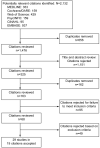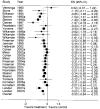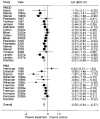Selective serotonin reuptake inhibitors for premenstrual syndrome and premenstrual dysphoric disorder: a meta-analysis
- PMID: 18448752
- PMCID: PMC2670364
- DOI: 10.1097/AOG.0b013e31816fd73b
Selective serotonin reuptake inhibitors for premenstrual syndrome and premenstrual dysphoric disorder: a meta-analysis
Abstract
Objective: To systematically review evidence of the treatment benefits of selective serotonin reuptake inhibitors (SSRIs) for symptoms related to severe premenstrual syndrome (PMS) and premenstrual dysphoric disorder.
Data sources: We conducted electronic database searches of MEDLINE, Web of Science, Cochrane Library, Embase, PsycINFO, and Cinahl through March 2007, and hand-searched reference lists and pertinent journals.
Methods of study selection: Studies included in the review were double-blind, randomized, controlled trials comparing an SSRI with placebo that reported a change in a validated score of premenstrual symptomatology. Studies had to report follow-up for any duration longer than one menstrual cycle among premenopausal women who met clinical diagnostic criteria for PMS or premenstrual dysphoric disorder. From 2,132 citations identified, we pooled results from 29 studies (in 19 citations) using random-effects meta-analyses and present results as odds ratios (ORs).
Tabulation, integration, and results: Our meta- analysis, which included 2,964 women, demonstrates that SSRIs are effective for treating PMS and premenstrual dysphoric disorder (OR 0.40, 95% confidence interval [CI] 0.31-0.51). Intermittent dosing regimens were found to be less effective (OR 0.55, 95% CI 0.45-0.68) than continuous dosing regimens (OR 0.28, 95% CI 0.18-0.42). No SSRI was demonstrably better than another. The choice of outcome measurement instrument was associated with effect size estimates. The overall effect size is smaller than reported previously.
Conclusion: Selective serotonin reuptake inhibitors were found to be effective in treating premenstrual symptoms, with continuous dosing regimens favored for effectiveness.
Figures




Similar articles
-
[Premenstrual dysphoric disorder (PMDD): Drug and psychotherapeutique management, a literature review].Encephale. 2024 Apr;50(2):211-232. doi: 10.1016/j.encep.2023.08.007. Epub 2023 Oct 9. Encephale. 2024. PMID: 37821319 Review. French.
-
Selective serotonin reuptake inhibitors for premenstrual dysphoric disorder: the emerging gold standard?Drugs. 2002;62(13):1869-85. doi: 10.2165/00003495-200262130-00004. Drugs. 2002. PMID: 12215058 Review.
-
Low-dose sertraline in the treatment of moderate-to-severe premenstrual syndrome: efficacy of 3 dosing strategies.J Clin Psychiatry. 2006 Oct;67(10):1624-32. doi: 10.4088/jcp.v67n1020. J Clin Psychiatry. 2006. PMID: 17107257 Clinical Trial.
-
Intermittent luteal phase sertraline treatment of dysphoric premenstrual syndrome.J Clin Psychiatry. 1997 Sep;58(9):399-402. doi: 10.4088/jcp.v58n0905. J Clin Psychiatry. 1997. PMID: 9378691 Clinical Trial.
-
Review of fluoxetine and its clinical applications in premenstrual dysphoric disorder.Expert Opin Pharmacother. 2002 Jul;3(7):979-91. doi: 10.1517/14656566.3.7.979. Expert Opin Pharmacother. 2002. PMID: 12083997 Review.
Cited by
-
Postgraduate corner: Continuing medical education.Indian J Psychiatry. 2008 Oct;50(4):298-300. doi: 10.4103/0019-5545.44755. Indian J Psychiatry. 2008. PMID: 19823618 Free PMC article. No abstract available.
-
Effects of periadolescent fluoxetine and paroxetine on elevated plus-maze, acoustic startle, and swimming immobility in rats while on and off-drug.Behav Brain Funct. 2011 Oct 5;7:41. doi: 10.1186/1744-9081-7-41. Behav Brain Funct. 2011. PMID: 21974752 Free PMC article.
-
Evidence-Based Treatment of Premenstrual Dysphoric Disorder: A Concise Review.J Clin Psychiatry. 2020 Feb 4;81(2):19ac13071. doi: 10.4088/JCP.19ac13071. J Clin Psychiatry. 2020. PMID: 32023366 Free PMC article. Review. No abstract available.
-
Epidemiology of Premenstrual Syndrome (PMS)-A Systematic Review and Meta-Analysis Study.J Clin Diagn Res. 2014 Feb;8(2):106-9. doi: 10.7860/JCDR/2014/8024.4021. Epub 2014 Feb 3. J Clin Diagn Res. 2014. PMID: 24701496 Free PMC article.
-
Recording and treatment of premenstrual syndrome in UK general practice: a retrospective cohort study.BMJ Open. 2016 Mar 18;6(3):e010244. doi: 10.1136/bmjopen-2015-010244. BMJ Open. 2016. PMID: 26993623 Free PMC article.
References
-
- Halbreich U, Borenstein J, Pearlstein T, Kahn LS. The prevalence, impairment, impact, and burden of premenstrual dysphoric disorder (PMS/PMDD) Psychoneuroendocrinology. 2003;28(suppl):1–23. - PubMed
-
- Rapkin AJ. New treatment approaches for premenstrual disorders. Am J Manag Care. 2005;11:S480–91. - PubMed
-
- Steiner M, Pearlstein T, Cohen LS, Endicott J, Kornstein SG, Roberts C, et al. Expert guidelines for the treatment of severe PMS, PMDD, and comorbidities: the role of SSRIs. J Womens Health (Larchmt) 2006;15:57–69. - PubMed
-
- Inoue Y, Terao T, Iwata N, Okamoto K, Kojima H, Okamoto T, et al. Fluctuating serotonergic function in premenstrual dysphoric disorder and premenstrual syndrome: findings from neuroendocrine challenge tests. Psychopharmacology (Berl) 2007;190:213–9. - PubMed
-
- Dimmock PW, Wyatt KM, Jones PW, O’Brien PM. Efficacy of selective serotonin-reuptake inhibitors in premenstrual syndrome: a systematic review. Lancet. 2000;356:1131–6. - PubMed
Publication types
MeSH terms
Substances
Grants and funding
LinkOut - more resources
Full Text Sources
Other Literature Sources
Medical
Research Materials
Miscellaneous

